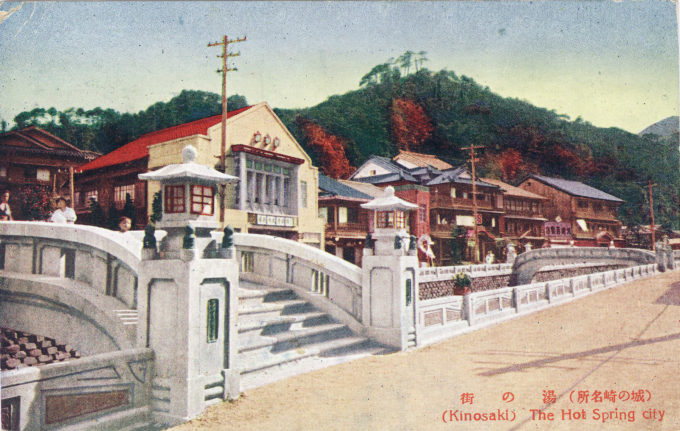
“Kinosaki, the Hot Spring city”, c. 1920. Kinosaki is located in northern Hyogo Prefecture on the coast of the Sea of Japan, app. 50-miles east of Tottori. Hot springs were discovered in Kinosaki around the 8th century, and the city is still considered to be one of the top onsen destinations of the Kansai Region.
See also:
Onsen culture.
The Natural Sand Baths and Onsen, Beppu, c. 1910-1930.
Dogo Onsen, Matsuyama (Iyo District), Shikoku, c. 1910.
“The six principal hot springs of Kinosaki, all earth, muriated common salt springs, which well out above ground, have been known since the 7th century for their merits from a medicinal point of view, and despite the number of inns (40 odd) there is often a lack of accommodation for the bathers who flock in (mostly from Kyoto and Osaka) in the New Year’s season and during the summer months. This spa is the most noted hot spring resort on the San-in Line, and the value of its waters is well known throughout Japan.
“… There are 6 bath houses. Three, the Ichi-no-yu, Jizo-no-yu, and Gosho-no-yu, have private baths: charges, 60 sen. None of the inns has baths.
“Local Specialties: Straw fancy-goods, white porcelain ware; furniture, cabinets, etc. made of mulberry wood, vunohana (sinter deposit of the springs).
“Kinosaki is on the W. bank of the Asago-gawa (the lower course of the Maruyama), which empties into the Japan Sea at the sea-port, Tsuiyama, 3 m. distant. Surrounded by hills, the town is noted for its beautiful scenery and salubrious climate. Population: 3,600.
“The main temple, dedicated to Kwannon, is one of the protected ‘National Structures’ and contains, amongst other treasures, an eleven faced image of the tutelary divinity. At the foot of the stone steps near by is another temple, Yakushi-do, in the midst of many cherry trees. The numerous stone lanterns in front of its gate are offerings from people in gratitude for their miraculous recovery to health by means of the hot springs of Kinosaki.”
– The Hot Springs of Japan, Japan Dept. of Railways, 1922

